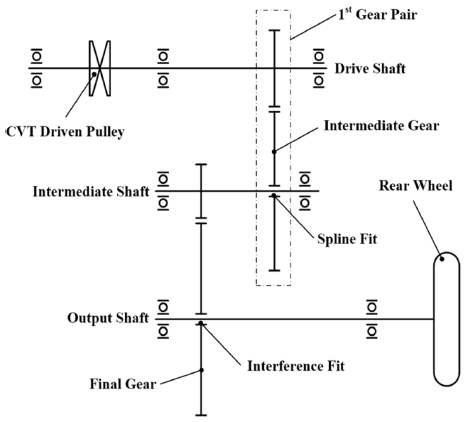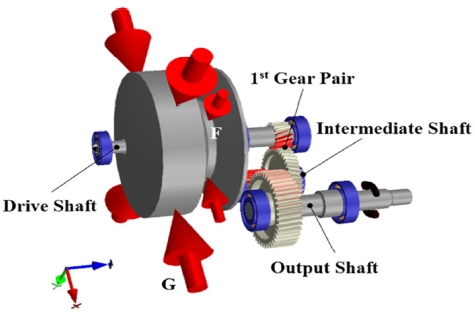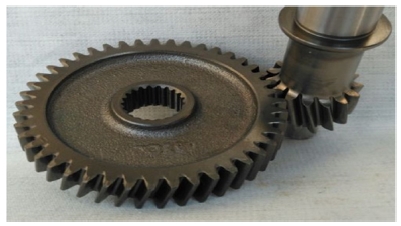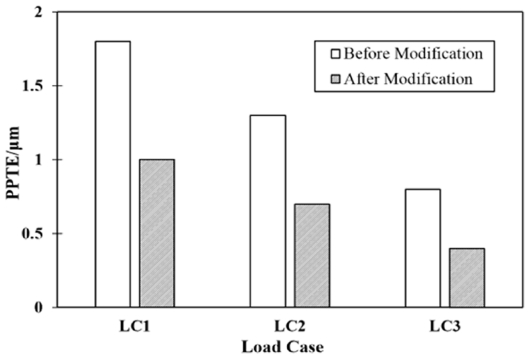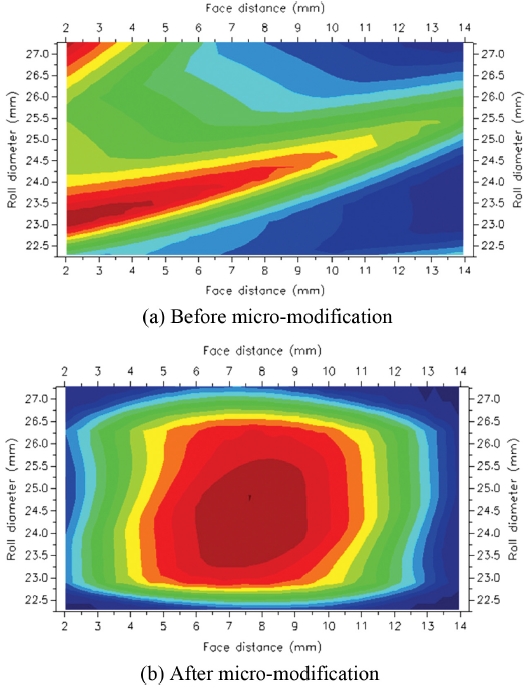
Simulation and Experimental Analysis for Noise Reduction of a Scooter Gearbox
Copyright © The Korean Society for Precision Engineering
This is an Open-Access article distributed under the terms of the Creative Commons Attribution Non-Commercial License (http://creativecommons.org/licenses/by-nc/3.0) which permits unrestricted non-commercial use, distribution, and reproduction in any medium, provided the original work is properly cited.
Abstract
Nowadays, noise, vibration, and harshness (NVH) is a comprehensive issue related to manufacturing quality, it gives the purchaser the most direct and superficial feeling. Following economic development, the improvement of people's living standards, and the expansion of the export market, it has become urgent to develop and produce some better NVH performance motorcycles. In this paper, the transmission of a scooter gearbox is modeled and analyzed by software. Then, the first helical gear pair of the gearbox was investigated through static analysis. Lastly, optimized modification was verified using B&K testing equipment in the semi-anechoic room. The comparison of the simulation to prototype during testing showed a good correlation, which means simulation optimization can greatly improve the research and development efficiency of the transmission system.
Keywords:
Scooter, Transmission error, Tooth micro-modification키워드:
스쿠터, 전달 오차, 치형 수정1. Introduction
Noise, Vibration and Harshness (NVH) is a comprehensive issue of manufacturing quality, it gives the purchaser the most direct and superficial feeling. With economic development, the improvement of people's living standards, as well as the needs of the export market, it is urgent to develop and produce some better NVH performance motorcycles.
The vibration and noise of the motorcycle have a great impact on people and are the core issues of NVH. Some countries have advanced motorcycle design and manufacturing technologies, and developed advanced software and hardware for comfort analysis and the research on the sound quality of motorcycles, which established general guidelines for human comfort. At present, it is a common solution, basically starting from the transmission path of the vibration and noise, to solve the vibration and noise of motorcycles.1-5
Transmission error (T.E.) is the most important factor of gear noise and vibration because transmission errors affect the changes of the force and the stiffness of gears.6,7 In this paper, the transmission of the scooter gearbox is modeled and analyzed by RomaxDesigner, the 1st helical gear pair of the gearbox has been investigated through static analysis, and through gear micro-modification, the gear pair and overall noise is reduced by minimizing gear PPTE. At last, simulation results of gear micro-modification are confirmed by noise and vibration measurement on bench testing. It was determined that the optimum gear micro-modification could be applied to minimize the transmission error and reduce the overall noise of the scooter gearbox.
2. Research Background
Scooter transmission system mainly consists of four components: drive shaft, intermediate gear, intermediate shaft and final gear assembly, and the schematic of the gearbox is shown in Fig. 1.
The speed of the scooter engine is transmitted through the belt between the driving pulley of CVT (Continuously Variable Transmission) on the crankshaft and the driven pulley on the drive shaft, different gear ratios are obtained by the changing diameters of the driving pulley and the driven pulley.
Engine power is driven by the belt to the drive shaft, and through the drive shaft meshing with the intermediate gear, and the intermediate gear and the intermediate shaft are fitted by involute spline, he intermediate shaft meshes with the final gear assembly (The final gear and the output shaft are assembled by interference fit.) to transmit power to the rear wheel on the output shaft to drive the scooter.
As the speed of scooter’s rear wheel is nearly up to thousands of revolutions, so these gears are high-speed rotating gears. Besides the CVT is mainly used for the engine in the scooter, due to large changes in transmission ratio and speed, the gear meshing between the driving gear of the input shaft and the intermediate gear (ESP. 1st gear pair) is the main part of the noise in this transmission system.
2.1 Scooter Noise
Scooter noise, according to the nature of its generation, is roughly divided into three categories: mechanical noise, aerodynamic noise and electromagnetic noise.
All of these are resulting from the interaction of the relevant components. The relationship of their composition is shown in Fig. 2.
The basic method to reduce the noise of the scooter is to control the main source of noise. Therefore, in order to control scooter noise, the noise source is firstly needed to be located to find the main sound source.
2.2 Influence Factors of Noise
Due to various errors in design, manufacturing and assembly, shock, vibration and mesh misalignment are generated during gear transmission, resulting in gearbox noise.
Scooter gearbox noise not only affects the engine performance, but also the commercial market, its main influence factors are as follows:
For gear macro-design, design noise can be reduced by increasing the contact ratio of a gear pair. According to the calculation formula of the transverse contact ratio, the specific methods are as follows: a) Increasing addendum coefficient is the most direct way, under the condition that the basic parameters such as gear pressure angle and module are the same, only increasing the addendum coefficient can reduce the noise. b) Small gear module and pressure angle. The advantage of the small module is that, with the same center distance of the gear pair, reducing the gear module can increase the number of gear teeth, so as to increase the gear contact ratio to reduce the gear noise.
Besides, due to the gear manufacturing error, the elastic and thermal deformation of the transmission system, the gear pair must have backlash. Reasonable backlash has a positive effect to decrease gear interference and collision noise. The principal factors affecting the gear backlash are the deviations of gearbox center distance and tooth thickness.
For gear micro-design, gear micro-modification is one of the most economical and effective ways to reduce gear noise.
For gear manufacturing quality, a reasonable choice of gear manufacturing accuracy is also the main measure to reduce gear noise. Usually ISO grade 7 accuracy level is not only economical and reasonable, but also to meet the requirements of the scooter. Judicious choice of gear materials and heat treatment process is necessary as well, and comprehensive analysis is used to avoid a variety of defects during the heat treatment process, thereby improving the accuracy of gears to reduce noise.
Besides, Gear machining process has a direct impact on the gear accuracy, appropriate gear profile finishing is an important method to control the base pitch deviation, tooth profile and lead error.
For scooter gear, shaving and honing processing are generally used, but for more precision gears, grinding processing is required, which bias error could be a by-product of crowned leads on helical gears.8,9 Therefor, bias compensation technique serves to have a lead crown correction that would create a uniform load distribution across the face width of the helical gear.
The noise reduction design of the case is another effective way to decrease the noise of the gearbox. In design stage, computer simulation can be employed to the design and the analysis of the case.
In order to find the weak parts and avoid the resonance, the vibration and the natural frequency of the prototype can be monitored and analyzed by the test instrument.
Gearbox assembly accuracy is one of the crucial factors that ensure the gear meshing transmission. Because each shaft is mounted on the gearbox through bearings, it is necessary to ensure the dimensional accuracy and the geometric tolerance of the relevant bearing holes.
In addition, the intermediate shaft and the intermediate gear are connected by involute splines. In the noise testing of the prototype, the assembly accuracy of the spline also has some impact on the gearbox noise.
Through analysis and testing, gear lubricating oil with additives has a certain effect to reduce gear noise. Due to the different grades of gear oil viscosity, it is necessary to consider all aspects of the application situation of gear lubricants.
From these studies,10,11 it is clearly found that the 1st gear pair is an important part of gear whine noise, noise reduction of this gear pair can effectively control the overall noise of the scooter, which the micro-modification of the gear pair is the focus of the study in this paper.
2.3 Gear Micro-Modification
As we all know, gear mesh is the origin of the gear whine noise, in which vibrations are excited by the transmission error during gear transmission, and the noise level is a direct result of the peak-to-peak transmission error (PPTE). For the gear noise reduction in the gear industry, gear micro-modifications is often used to decrease tooth corner contact and dynamic excitation of the gear pair. Such modifications can be utilized to make up for the teeth deflections under the loaded torque. Micro-modifications can be applied on the involute and lead of gear teeth, in this paper, empirical gear profile micro-modification and lead crown are implemented for 1st gear pair. And the gear tip modification amount is about 0.02 mn, the modification length is 0.65 mn, and mn is gear module.12
3. Simulation and Experimental Analysis
In order to inspect the effect of gear profile micro-modification and reduce gearbox noise, a scooter gearbox without case housing (The impact of gearbox housing stiffness is not considered.13) is modeled in RomaxDesigner software to investigate the T.E. under the design torques, which G is the gravity of CVT driven pulley and F is the tension force of CVT belt. Fig. 3 is the modeling of a scooter gearbox without housing, Fig. 4 it the 1st helical gear pair, and Table 1 is the summary of the specification of the 1st gear pair of the gearbox.
As we known, micro-modification parameters cannot be varied individually to evaluate the sensitivity of the durability and NVH performance, and even ideal designs can rarely be manufactured for mass production. But in order to quickly evaluate the results of the nominal modification, esp. profile tip relief, only nominal values of gear micro-modification are used for this gear pair without the consideration of manufacturing tolerance. And the nominal modification parameters are given in Table 2. The typical input loaded torques are 10.79 Nm, 7.46 Nm and 4.79 Nm which are named as Load Case 1 (LC1), Load Case 2 (LC2) and Load Case 3 (LC3) respectively. By simulation, PPTE before and after gear micro-modification is obtained as shown in Fig. 5. Transmission error is reduced at all load cases. And contact patter of one load case before and after modification is shown in Fig. 6.
Along the tooth width direction, left tooth edge is loaded with more loads compared to right edge, which is optimized so that both edge receives balanced load. The contact load distribution shows that the optimized has avoided edge contact, and the load is distributed over a wide area of the tooth, maximum contact load is close to the center of gear width.
A design with very good performance may give inferior performance in experimental conditions. It is important to correlate the simulation results with actual experimental results of a gear pair to confirm accuracy of transmission model and analysis condition during CAE. In order to acquire gear noise and vibration data, the gearbox is tested in a semi-anechoic room as shown in Fig. 7. Noise and Vibration data was acquired by B&K testing software in run-up and run-down condition without specific torque applied at the input shaft of the gearbox (Scooter purchasers always test in situ which means the load of the drive shaft is small.). Example comparison for 1st gear pair and overall in run-up noise is illustrated in Fig. 8. It shows that the noise level is improved in dB for 1st gear pair and overall after gear micro-modification. It is possible to conclude that simulation results of gear micro-modification are confirmed by noise and vibration measurement on bench testing.
4. Conclusion
Time and cost are two critical parameters for the transmission development, which means durability, efficiency and NVH performance must be confirmed as early as possible during production development. In this paper, the transmission of the scooter gearbox is modeled and analyzed by RomaxDesigner, the 1st helical gear pair of the gearbox has been investigated through static analysis, and through gear micro-modification, the gear pair and overall noise is reduced by minimizing gear PPTE. The comparison of the simulation to prototype testing shows good correlation. Traditional mode of experimentation with repeated prototyping can be avoided, which means simulation optimization can greatly improve the research and development efficiency of the transmission system.
Acknowledgments
This study was supported by Basic Science Research Program through the NRF of Korea (NRF) funded by the MEST (NRF-2016R1D1A1A09920105) & many thanks for the help from Haojue R&D Center.
REFERENCES
- Wei, J. Y. L. M. B. and Fengrong, B., “Brief Introduction for the Research of NVH Technology on Motorcycle,” Motorcycle Technology, No. 3, pp. 11-15, 2005.
-
Jen, M. U. and Lu, M.-H., “Experimental Root Cause Diagnosis for Scooter NVH Problem,” Proc. of the SAE Noise & Vibration Conference, p. 9, 2003.
[https://doi.org/10.4271/2003-01-1426]

- Welbourn, D., “Fundamental Knowledge of Gear Noise: A Survey,” Proc. of Cranfield Institute of Technology Society of Automotive Engineers Institution of Mechanical Engineers, pp. 9-14, 1979.
-
Kim, J., Park, Y., Lee, G., and Kim, J., “Effect Analysis of Carrier Pinhole Position Error on the Load Sharing of Planetary Gear,” Journal of the Korean Society of Manufacturing Process Engineers, Vol. 15, No. 4, pp. 67-72, 2016.
[https://doi.org/10.14775/ksmpe.2016.15.4.067]

-
Lee, K. and Kim, J., “Power Flow Analysis for Manufacturing of Planetary Gears in an 8-Speed Automatic Transmission (II) : 4 - 8 Speeds,” Journal of Korean Society Manufacturing Process Engineer, Vol. 15, No. 5, pp. 57-65, 2016.
[https://doi.org/10.14775/ksmpe.2016.15.5.057]

-
Kim, J., Park, Y., Lee, G., and Kim, J., “Effect Analysis of Carrier Pinhole Position Error on the Load Sharing of Planetary Gear,” Journal of the Korean Society of Manufacturing Process Engineers, Vol. 15, No. 4, pp. 67-72, 2016.
[https://doi.org/10.14775/ksmpe.2016.15.4.067]

- Houser, D. R., Harianto, J., and Ueda, Y., “Determining the Source of Gear Whine Noise,” Gear Solutions, Vol. 1623, 2004.
- Lange, J., “How are You Dealing With the Bias Error in Your Helical Gears,” Gear Solutions, pp. 47-54, 2009.
- Türich, A., “Producing Profile and Lead Modifications in Threaded Wheel and Profile Grinding,” Gear Technology, Vol. 27, No. 1, pp. 54-62, 2010.
-
Noh, S. Y., Kim, L. S., Cho, S. H., and Lyu, S. K., “Study on the Tooth Micro-Geometry Optimization of Planetary Gear for Drive Reducer,” Jornal of the Korean Society Precision Engineering, Vol. 34, No. 6, pp. 371-376, 2017.
[https://doi.org/10.7736/KSPE.2017.34.6.371]

- Zhu, C.-C., Huang, Z.-H., and Tang, Q., “Influence of Motorcycle Noise on Gear Transmission,” Journal of Chongqing University (Natural Science Ed.), Vol. 5, p. 4, 2005.
- Zhang, Q., Wang, J.-G., and Lyu, S.-K., “Study on Empirical Gear Profile Micro-Modifications for Gear Transmission,” Journal of the Korean Society of Manufacturing Process Engineers, Vol. 16, No. 3, pp. 54-62, 2017.
- Coultate, J., Zhang, Z., Halse, C., Crowther, A. R., and House, R., “The Impact of Gearbox Housing and Planet Carrier Flexibility on Wind Turbine Gearbox Durability,” Proc. of European Wind Energy Conference, pp. 1-8, 2009.

